To master herbal tea proportions, start with a 3:1 ratio of base herbs to accent herbs. Adjust this based on flavor intensity and desired benefits. Use precise measuring tools like digital scales for consistency. Experiment with single-herb teas or create multi-herb blends, balancing flavors and therapeutic effects. Consider seasonal adjustments and proper storage techniques to maintain freshness. Pay attention to steeping times and temperatures for ideal taste and potency. Avoid common mistakes like oversteeping or ignoring herb potency. By understanding these key aspects, you'll be well on your way to crafting perfectly balanced herbal tea blends. The journey to becoming a tea blending expert is just beginning.
Understanding Tea Blend Ratios
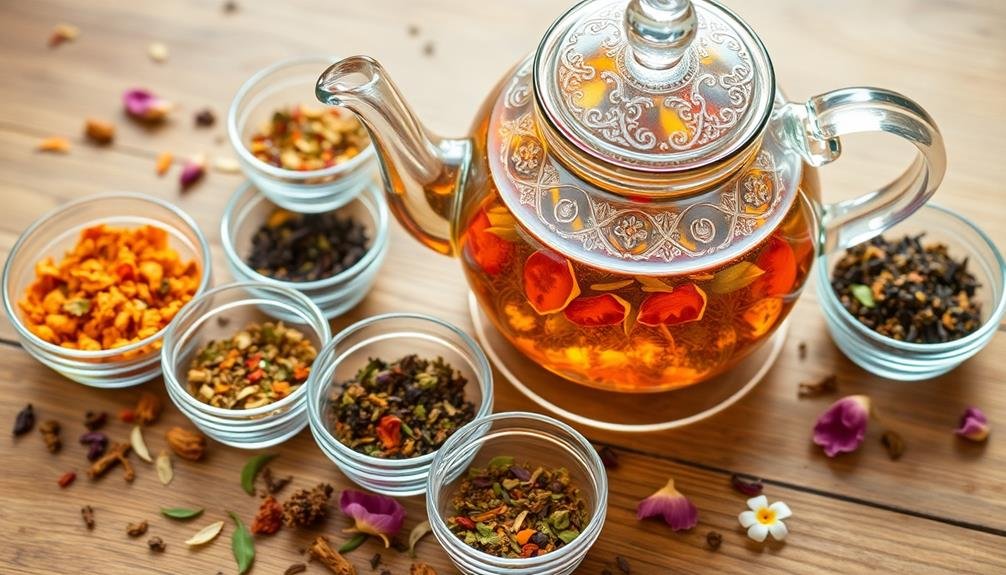
Frequently, creating the perfect herbal tea blend comes down to understanding the right ratios. When you're crafting your own herbal tea mixtures, it's essential to balance the flavors, aromas, and therapeutic properties of each ingredient.
A general rule of thumb is to use a 3:1 ratio of base herbs to accent herbs. This means for every three parts of your primary herb, you'll add one part of a complementary or supporting herb.
For example, if you're making a calming blend, you might use three parts chamomile as your base and one part lavender as your accent. This ratio guarantees that the main flavor and benefits of the chamomile aren't overpowered by the lavender's strong aroma.
You can adjust these ratios based on personal preference or specific health goals. If you're adding strong flavors like peppermint or ginger, you'll want to use them sparingly, perhaps in a 4:1 or even 5:1 ratio with other herbs.
Essential Herbs for Tea Blending
To create your own herbal tea blends, you'll need to familiarize yourself with popular herbal tea bases.
These foundational herbs, such as chamomile, peppermint, and rooibos, form the backbone of many tea combinations.
You can then enhance these bases with complementary flavors, experimenting with herbs like lavender, lemon balm, or ginger to craft unique and personalized tea blends.
Popular Herbal Tea Bases
At the heart of any great herbal tea blend lie essential base herbs. These foundational ingredients provide the backbone of your tea's flavor profile and often make up the largest proportion of your blend. Some popular herbal tea bases you'll want to take into account include chamomile, peppermint, rooibos, and hibiscus.
Chamomile is renowned for its calming properties and subtle apple-like flavor. It's an excellent base for evening blends or teas designed to promote relaxation.
Peppermint, with its cooling and invigorating taste, serves as a versatile base that pairs well with many other herbs. It's particularly effective in digestive blends.
Rooibos, a caffeine-free South African herb, offers a nutty, slightly sweet flavor that works well in both hot and iced teas. It's rich in antioxidants and makes an excellent base for fruit-forward blends.
Hibiscus, with its tart and tangy profile, provides a vibrant red color and revitalizing taste. It's often used in summer blends and pairs wonderfully with citrus flavors.
When selecting your base herb, contemplate its flavor intensity, health benefits, and how it complements other ingredients in your blend.
Experimenting with different bases will help you create unique and delicious herbal tea combinations.
Complementary Flavor Combinations
Building upon your chosen base, complementary herbs can elevate your tea blend to new heights. To create harmonious flavor profiles, consider these classic combinations:
For chamomile base, add lavender for a soothing, floral blend or lemon balm for a bright, citrusy twist.
Peppermint pairs well with spearmint or lemongrass, creating a revitalizing and invigorating mix. Enhance rooibos with vanilla and cinnamon for a warm, dessert-like infusion.
When using green tea as your base, try adding jasmine flowers for a fragrant boost or ginger for a spicy kick.
Black tea blends beautifully with bergamot (Earl Grey) or cardamom and cloves (chai). For hibiscus, combine with rosehips and lemon peel for a tart, vitamin C-rich blend.
Don't shy away from unexpected pairings. Experiment with herbs like holy basil, nettle, or licorice root to add depth and complexity.
Remember to start with small amounts of complementary herbs, typically 1/4 to 1/3 of your base ingredient. This allows you to adjust and perfect your blend without overpowering the primary flavor.
With practice, you'll develop an intuitive sense for creating unique and delicious herbal tea combinations.
Balancing Flavors in Herbal Teas
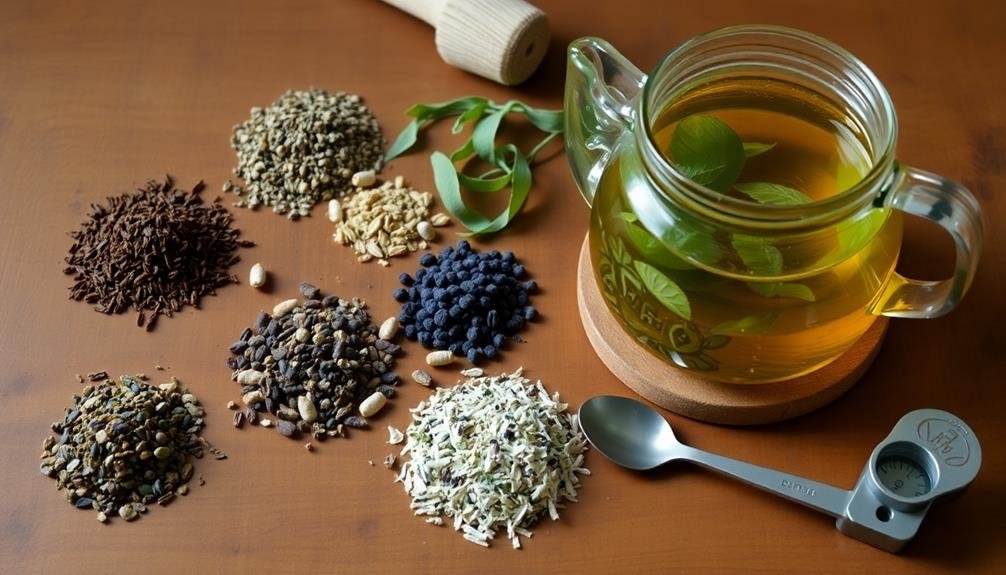
When crafting the perfect herbal tea blend, balancing flavors is essential for a harmonious and enjoyable drink. You'll want to take into account the strength and intensity of each ingredient to create a well-rounded flavor profile.
Start by identifying your base herb, which will make up the largest proportion of your blend. This could be chamomile, peppermint, or rooibos, for example.
Next, add complementary herbs to enhance the base flavor or introduce new notes. Use stronger flavors sparingly to avoid overpowering the blend. For instance, if you're using licorice root or ginger, add them in small quantities.
Floral elements like lavender or rose petals should be used lightly to provide subtle aromatics without dominating the taste.
Reflect on the mouthfeel of your tea as well. Ingredients like marshmallow root can add smoothness, while lemon verbena can contribute brightness. To balance sweetness, try adding a small amount of stevia leaf or a touch of cinnamon.
Remember that some herbs, like hibiscus, can be quite tart, so you may need to counterbalance them with sweeter elements. Experiment with different ratios until you find the perfect balance for your palate.
Measuring Tools for Tea Blending
When blending herbal teas, you'll need accurate measuring tools to guarantee consistent results.
Essential kitchen scales, measuring spoons, and cups are your go-to equipment for precise herb portioning.
You'll want to contemplate whether to measure by volume or weight, as each method has its advantages in tea blending.
Essential Kitchen Scale Types
Precision measurement is essential for creating the perfect herbal tea blend. When it comes to kitchen scales for tea blending, you'll find several types that can help you achieve accuracy in your measurements.
Digital scales are the most common and user-friendly option. They provide quick, precise readings and often come with additional features like tare function and multiple unit conversions. Look for models with a 0.1-gram resolution for ideal tea blending precision.
Mechanical scales, though less common, offer reliability without the need for batteries. They're durable and can handle larger quantities, but they may not be as precise as digital options for small measurements.
Pocket scales are perfect for on-the-go tea enthusiasts. They're compact, lightweight, and ideal for measuring small quantities of herbs and teas. Many pocket scales offer precision down to 0.01 grams, making them excellent for creating single-serve blends.
Balance scales, while less common in modern kitchens, provide a traditional approach to measuring. They're great for visual learners and can be highly accurate when used correctly.
However, they require more time and practice to master compared to digital alternatives.
Measuring Spoons and Cups
While scales offer precision, measuring spoons and cups are indispensable tools for quick and convenient tea blending. You'll find these in most kitchens, making them easily accessible for your herbal tea adventures. Measuring spoons typically come in sets ranging from 1/8 teaspoon to 1 tablespoon, while measuring cups cover 1/4 cup to 1 cup increments.
When using these tools, it's essential to understand their limitations. They're best for dry ingredients and may not be as accurate for finely ground herbs or dense materials. Always level off your measurements for consistency, and remember that a heaping spoon can greatly alter your blend's flavor profile.
Here's a quick reference guide for common herbal tea measurements:
| Ingredient | Teaspoon | Tablespoon | Cup |
|---|---|---|---|
| Dried Leaves | 1-2 tsp | 1 tbsp | 1/4 cup |
| Flower Petals | 1-3 tsp | 2 tbsp | 1/3 cup |
| Roots/Bark | 1/2-1 tsp | 1/2 tbsp | 2 tbsp |
| Seeds | 1/4-1/2 tsp | 1 tsp | 1 tbsp |
| Powders | 1/8-1/4 tsp | 1/2 tsp | 1 tsp |
Volume vs. Weight Considerations
Understanding the difference between volume and weight measurements is essential when blending herbal teas. While volume measurements like teaspoons and cups are convenient, they can be inconsistent due to variations in herb density and particle size. Weight measurements, on the other hand, offer greater precision and consistency.
When you're working with lightweight herbs like chamomile flowers or peppermint leaves, volume measurements may suffice. However, for denser ingredients like roots or seeds, weight measurements are vital. A teaspoon of fennel seeds, for instance, will weigh considerably more than a teaspoon of dried lemon balm leaves.
To guarantee accuracy, invest in a digital scale that measures in grams. This will allow you to create repeatable blends and maintain consistent ratios. When following recipes, pay attention to whether they specify volume or weight measurements. If a recipe uses volume, you can convert it to weight for better precision.
Remember that water displacement isn't always reliable for measuring herbs, as some float or absorb water. Stick to dry measurements for your ingredients.
Single-Herb vs. Multi-Herb Blends
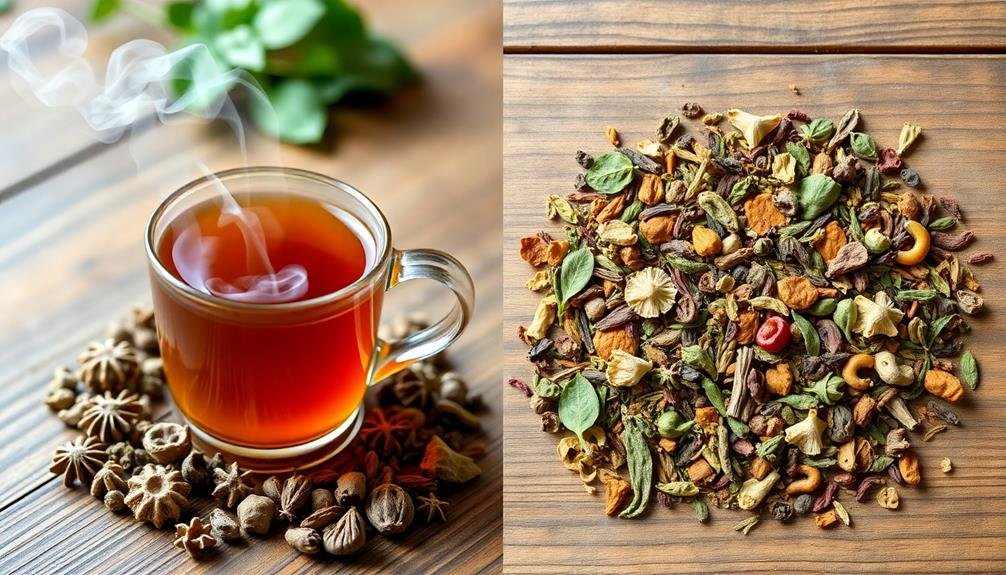
When it comes to herbal tea, you'll encounter two main types: single-herb and multi-herb blends. Single-herb teas are straightforward, allowing you to experience the pure flavor and benefits of one specific herb. They're ideal for beginners or those who want to familiarize themselves with individual herbs' characteristics.
Multi-herb blends, on the other hand, combine two or more herbs to create complex flavors and synergistic effects.
When crafting multi-herb blends, consider the following:
- Base herbs: These make up the bulk of your blend (50-80%)
- Supporting herbs: Add depth and enhance the base (15-30%)
- Accent herbs: Provide subtle notes or specific benefits (5-15%)
- Flavor enhancers: Optional additions like citrus peels or spices (1-5%)
Start with a 2:1 ratio when combining two herbs, adjusting as needed. For three or more herbs, begin with equal parts and modify to taste.
Remember that some herbs have stronger flavors or effects than others, so you'll need to balance them carefully. Don't be afraid to experiment, but keep notes on your blends to replicate successful combinations.
With practice, you'll develop a keen sense for creating harmonious and effective herbal tea blends.
Proportions for Caffeine-Free Blends
Crafting caffeine-free herbal tea blends requires a different approach than working with caffeinated teas. When creating these blends, you'll need to focus on balancing flavors and therapeutic properties without relying on the bold notes of caffeinated leaves.
Start with a base herb that makes up 50-60% of your blend. Popular choices include chamomile, rooibos, or peppermint. These provide a foundation for your tea's flavor profile.
Next, add 20-30% of complementary herbs to enhance the base. For example, pair lavender with chamomile or lemongrass with rooibos.
Include 10-15% of accent herbs to add depth and complexity. Spices like cinnamon, ginger, or cardamom work well in small amounts.
Finally, incorporate 5-10% of functional herbs for specific health benefits, such as elderberry for immune support or valerian root for relaxation.
Remember to adjust these proportions based on the strength and flavors of individual herbs. Strong-tasting herbs like peppermint or licorice root should be used sparingly.
Always taste-test your blends and refine the ratios until you achieve the desired flavor and effect. With practice, you'll develop a knack for creating balanced, delicious caffeine-free herbal tea blends.
Steeping Times and Temperatures
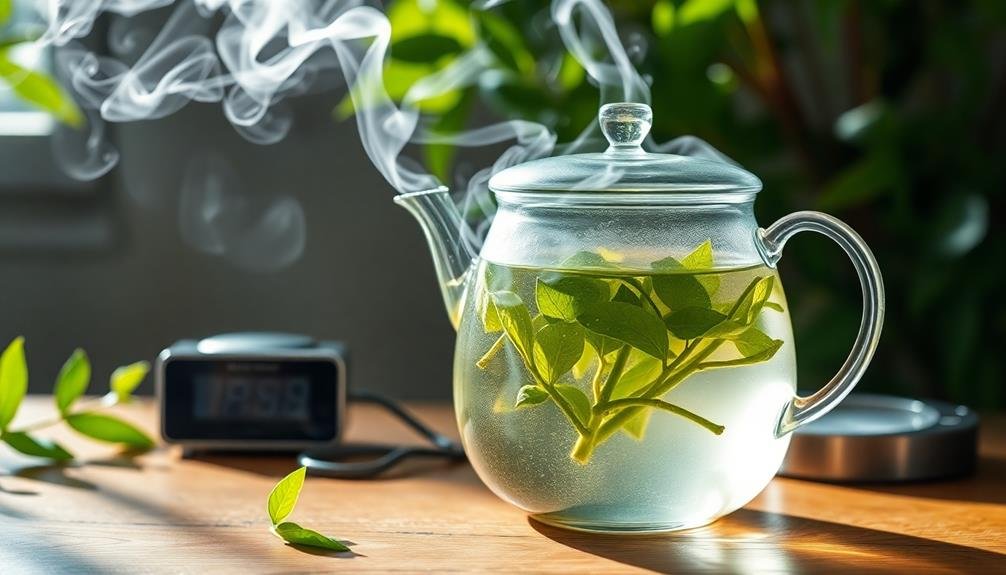
To achieve the perfect cup of herbal tea, you'll need to pay close attention to steeping times and temperatures. Different herbs require specific conditions to release their full flavor and beneficial properties. Generally, herbal teas benefit from longer steeping times and higher temperatures compared to traditional teas.
For most herbal teas, use water that's just off the boil, around 200-212°F (93-100°C). Steep for 5-10 minutes, depending on the herbs and your desired strength. Delicate herbs like chamomile or mint may need only 3-5 minutes, while stronger blends with roots or bark might require up to 15 minutes.
Here's a quick guide for common herbal teas:
- Chamomile: 3-5 minutes at 200°F (93°C)
- Peppermint: 5-7 minutes at 205°F (96°C)
- Ginger: 5-10 minutes at 212°F (100°C)
- Rooibos: 5-7 minutes at 212°F (100°C)
Dried vs. Fresh Herb Ratios
Now that you've mastered the art of steeping, let's consider another essential factor in herbal tea preparation: the ratio of dried to fresh herbs. Understanding this ratio is vital for achieving the perfect flavor and potency in your herbal infusions.
As a general rule, you'll need about three times the amount of fresh herbs compared to dried ones. This is because fresh herbs contain more water, which dilutes their flavor. For example, if a recipe calls for 1 teaspoon of dried peppermint, you'd use 3 teaspoons of fresh peppermint leaves.
However, this ratio isn't set in stone. Some herbs, like rosemary or thyme, are more potent when fresh and may require less than the 3:1 ratio. Conversely, delicate herbs like basil might need more than triple the amount when fresh.
When substituting dried herbs for fresh, start with 1/3 the amount and adjust to taste. Remember that dried herbs often have a more concentrated flavor, so you'll need less to achieve the same intensity.
Always store your dried herbs properly to maintain their potency and flavor over time.
Enhancing Blends With Spices
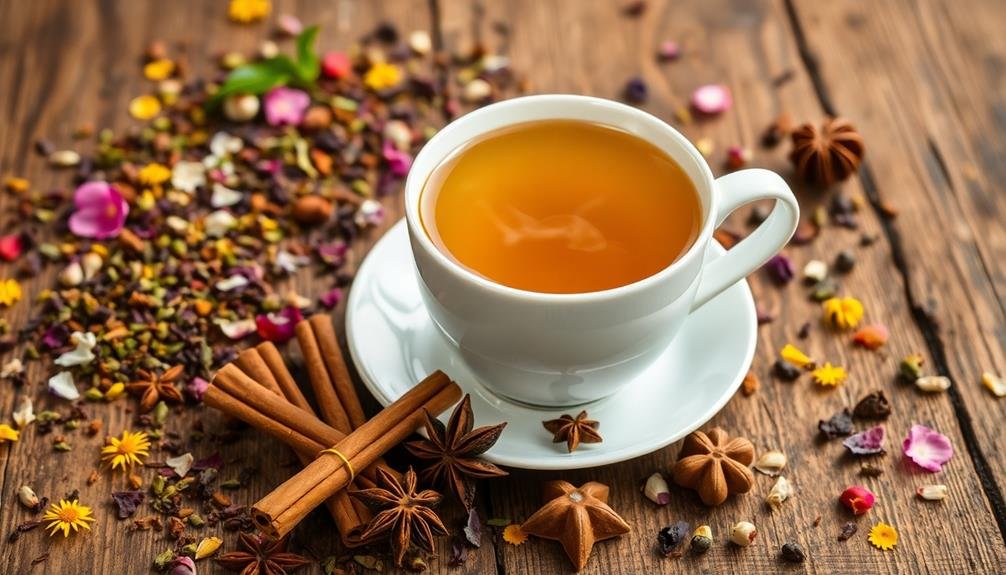
Spices can take your herbal tea blends up a notch, adding depth and complexity to your favorite infusions. When incorporating spices, start with small amounts and adjust to taste. A little goes a long way, especially with potent spices like cinnamon, ginger, or cardamom. For a balanced blend, aim for about 1/4 to 1/2 teaspoon of ground spices per cup of dried herbs.
Whole spices can be used as well, but you'll need to crush or grind them to release their flavors effectively. Consider using a mortar and pestle or a spice grinder for the best results.
Remember that some spices, like star anise or cloves, have strong flavors that can easily overpower other ingredients, so use them sparingly.
Here are some popular spices to experiment with in your herbal tea blends:
- Cinnamon: Adds warmth and sweetness
- Ginger: Provides a spicy kick and digestive benefits
- Cardamom: Offers a unique, aromatic flavor
- Nutmeg: Contributes a subtle, nutty taste
Don't be afraid to mix and match spices to create your own signature blends. Keep notes on your experiments to refine your recipes over time.
Seasonal Tea Blend Adjustments
As the seasons change, so can your herbal tea blends. Adjusting your tea proportions throughout the year allows you to create season-specific flavors and address changing wellness needs.
In spring, you might increase the ratio of detoxifying herbs like dandelion or nettle to support your body's natural cleansing processes. For summer blends, consider adding more cooling herbs such as peppermint or lemon balm, while reducing warming spices.
As autumn approaches, you'll want to boost immune-supporting herbs like echinacea and elderberry. Increase the proportion of warming spices like cinnamon and ginger to help ward off the chill.
Winter blends can benefit from a higher ratio of adaptogenic herbs like ashwagandha or holy basil to combat stress and support overall wellness. You might also amp up the warming qualities with additional ginger or cayenne.
Remember to adjust steeping times for seasonal blends. Cooling summer teas often require shorter steeps, while heartier winter blends may need longer infusion times.
Storage and Shelf Life
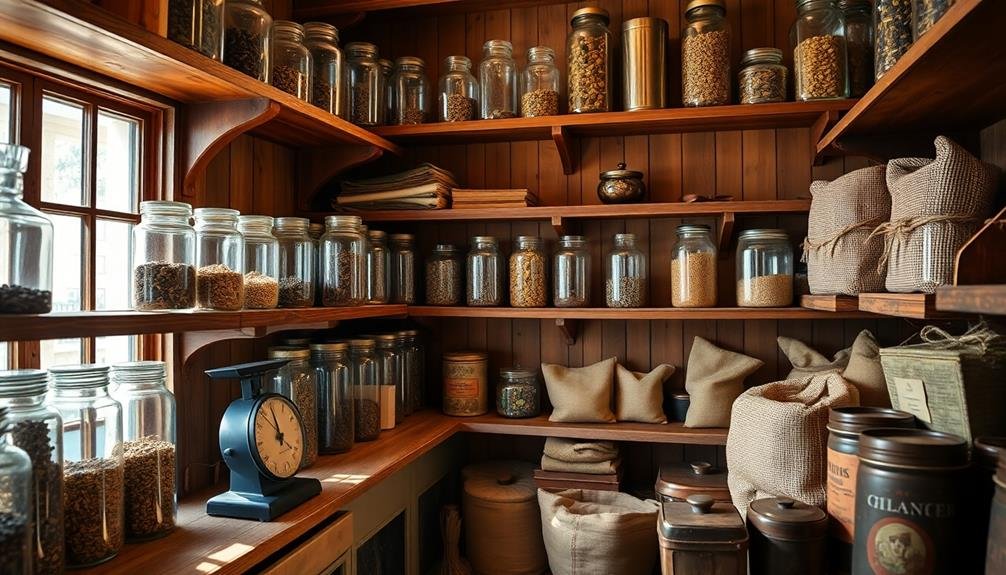
To keep your herbal tea blends fresh and flavorful, you'll need to master proper storage techniques.
Store your teas in airtight containers away from light, heat, and moisture to prevent degradation.
Proper Storage Techniques
Proper storage techniques are essential for maintaining the quality and flavor of your herbal tea blends. To preserve your teas' freshness and potency, store them in airtight containers away from light, heat, and moisture. Glass jars with tight-fitting lids or opaque ceramic containers work well for this purpose.
Keep your tea collection in a cool, dark place like a pantry or cupboard, avoiding areas near stoves or windows where temperatures fluctuate.
When storing different herbs together, be mindful of cross-contamination. Strong-scented herbs like peppermint or lemon balm can impart their flavors to milder ones, so it's best to keep them separate.
Label your containers with the herb name and date of purchase or harvesting to track freshness.
For ideal storage, consider these tips:
- Use airtight containers to prevent moisture and air exposure
- Store in a cool, dark place to maintain potency
- Keep strong-scented herbs separate from milder ones
- Label containers with herb names and dates
Extending Tea Longevity
Longevity is key when it comes to preserving your herbal tea collection. To extend your tea's shelf life, start by storing it in airtight containers away from light, heat, and moisture. Glass or ceramic jars with tight-fitting lids work well, but opaque containers are even better for light-sensitive herbs.
Keep your tea away from strong odors, as herbs can absorb surrounding scents. Store different tea varieties separately to prevent flavor mixing. Place your containers in a cool, dark place like a pantry or cupboard, maintaining a consistent temperature around 60-70°F (15-21°C).
For loose leaf teas, aim to use them within 6-12 months for peak freshness. Whole leaf teas generally last longer than crushed or powdered varieties. Tea bags have a shorter lifespan due to increased surface area exposure.
Consider vacuum-sealing larger quantities or freezing delicate herbs for long-term storage. However, only freeze completely dry herbs to prevent ice crystals from forming.
When removing tea from the freezer, let it come to room temperature before opening to avoid condensation.
Health Benefits of Herbal Ratios
While many people enjoy herbal teas for their flavors, the ratios of different herbs in your blend can considerably impact their health benefits. By carefully balancing your herbal combinations, you'll maximize the therapeutic potential of your tea.
For instance, a higher proportion of chamomile in a sleep-inducing blend can enhance its calming effects, while increasing the amount of ginger in a digestive tea can boost its ability to soothe an upset stomach.
Understanding the synergistic effects of herbs is vital. Some combinations can amplify each other's benefits, while others may counteract or diminish their individual properties. You'll want to research the specific herbs you're using and their interactions to create the most effective blends for your health goals.
Here are some key considerations when crafting herbal tea ratios for health benefits:
- Potency: Stronger herbs may require smaller proportions
- Taste balance: Guarantee palatability while maintaining therapeutic effects
- Individual sensitivities: Adjust ratios based on your body's reactions
- Specific health targets: Prioritize herbs that address your primary concerns
Common Blending Mistakes to Avoid
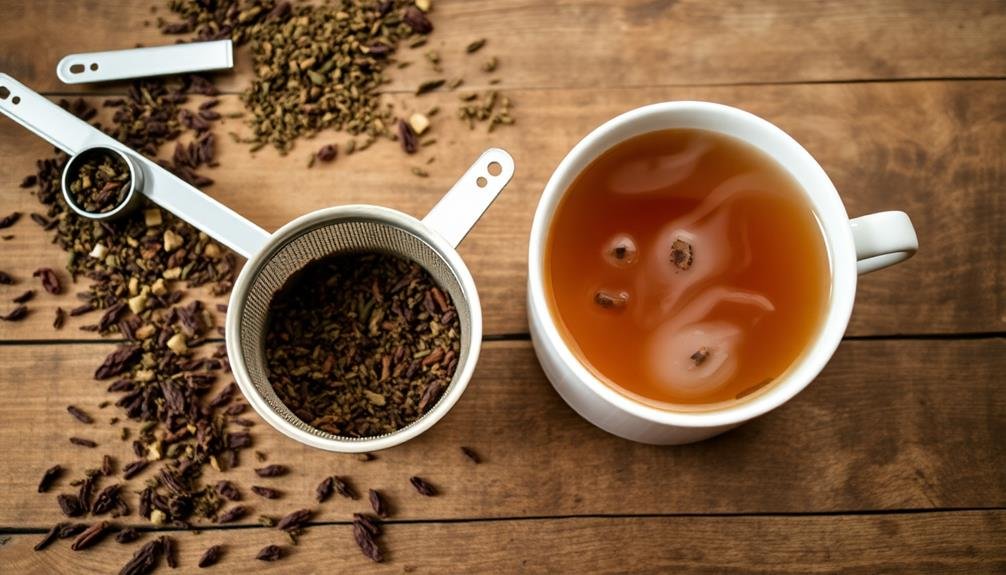
Many tea enthusiasts make common mistakes when blending herbal teas, which can lead to disappointing results or even potential health risks. To avoid these pitfalls, you'll need to be mindful of several key factors.
First, don't overlook the importance of proper measurements. Eyeballing ingredients can result in overpowering flavors or weak brews. Always use a scale or measuring spoons for accuracy. Second, avoid mixing too many herbs at once. Stick to 3-5 ingredients to maintain a balanced flavor profile and prevent conflicting effects.
Here's a quick reference guide to common blending mistakes and how to avoid them:
| Mistake | How to Avoid |
|---|---|
| Oversteeping | Follow recommended brew times |
| Ignoring herb potency | Research each herb's strength |
| Combining conflicting herbs | Check for potential interactions |
| Using low-quality ingredients | Source from reputable suppliers |
Lastly, don't forget to reflect on the medicinal properties of herbs. Some combinations may intensify effects or cause adverse reactions. Always research potential interactions and consult with a healthcare professional if you're unsure about a blend's safety, especially if you're taking medications or have existing health conditions.
Frequently Asked Questions
Can I Use Herbal Tea Blends for Cooking or Baking?
Yes, you can use herbal tea blends for cooking and baking. They'll add unique flavors to your dishes. Try infusing them in sauces, marinades, or baked goods. You'll discover new taste dimensions in your culinary creations.
How Do Herbal Tea Blends Interact With Medications?
You should be cautious when combining herbal tea blends with medications. Some herbs can interact with drugs, altering their effectiveness or causing side effects. Always consult your doctor or pharmacist before drinking herbal teas while on medication.
Are There Any Herbal Teas Safe for Pets to Consume?
You'll find some herbal teas are safe for pets, but many aren't. Chamomile and catnip are generally okay for cats and dogs. Always consult your vet before giving pets any tea, as some can be harmful or toxic.
Can I Grow My Own Herbs for Tea Blending Indoors?
Yes, you can grow herbs for tea indoors. Start with easy-to-grow options like mint, lemon balm, or chamomile. Use well-draining soil, provide adequate light, and guarantee proper watering. You'll soon have fresh herbs for your tea blends.
Are There Specific Blends That Can Help With Sleep or Digestion?
Yes, you'll find specific herbal blends that can aid sleep and digestion. For sleep, try chamomile, lavender, and valerian root. For digestion, consider peppermint, ginger, and fennel. Experiment with these herbs to create your perfect soothing blend.
In Summary
You've now got the tools to create perfect herbal tea blends. Remember, it's all about experimentation and finding what works for you. Don't be afraid to adjust ratios, try new herbs, or adapt blends for the seasons. With practice, you'll develop an intuitive sense for balancing flavors and maximizing health benefits. Keep your blends fresh, avoid common mistakes, and most importantly, enjoy the process of crafting your own unique herbal teas.

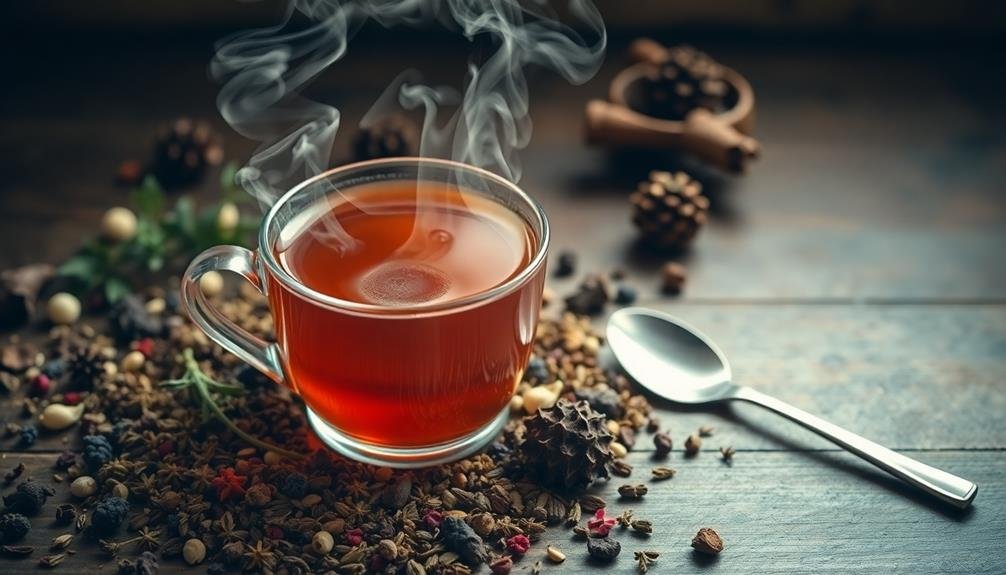



Leave a Reply